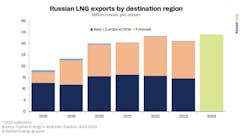Market trends never last unless governments try to reverse the ones they dislike. While no one expects crude oil prices to plummet anytime soon, adjustments have begun. Governments should let them work.
This year, global oil demand growth, paced by China and the US, has outrun expectations and strained supply. Lately, the American side of the demand dynamo has begun to cool.
The main component of US demand strength has been gasoline. Until the past few weeks, gasoline use this year had run strongly ahead of corresponding levels of 2003. Now they about match 2003 robust levels, according to data reported by the US Energy Information Administration. EIA expects year-over-year gasoline demand growth in the second half to average 1.3%, compared with 2.3% in the first half. The apparent slowdown signals a consumption response, long in coming, to prices historically high before adjustments for inflation.
Economy slows
Growth of the US economy also is slowing under the weight of elevated energy prices. The Federal Open Market Committee of the Federal Reserve on Aug. 10 raised its target for the federal funds rate, which banks charge one another for overnight loans, to 1.5% from 1.25%.
"In recent months, output growth has moderated, and the pace of improvement in labor market conditions has slowed," the committee said in a statement. "This softness likely owes importantly to the substantial rise in energy prices." The statement noted a modest revival of inflation this year but expressed confidence about future growth. However long it lasts, though, suppression of economic growth joins price-induced conservation as a constraint on demand for petroleum products.
Global supply is adjusting to the elevation of oil prices, too, but still strains to meet demand. The International Energy Agency's August Oil Market Report says production increased by 550,000 b/d in July, mostly from Iraq. Other members of the Organization of Petroleum Exporting Countries are producing crude at nearly capacity rates. In fact, unused capacity to produce crude—all controlled by OPEC members—has shrunk to no more than 1 million b/d worldwide. The consequently diminished ability of producers to compensate for sudden supply losses by tapping idle capacity is a strong factor in recent price strength and a reason prices spurt with every hint of a supply problem.
Although not yet out of jeopardy, the market is rebuilding its buffers. Recent increases in OPEC crude production—more than 1 million b/d since April—and isolated non-OPEC gains, especially Russia's, have lifted oil inventories above the perilously low levels at which they languished earlier this year. And new production capacity is under development. IEA expects OPEC's ability to produce crude subject to quota to increase by a net 370,000 b/d this year and 2.1 million b/d during 2005-07. That's not enough to cover demand growth projected for the period, but it helps. And production growth is likely to continue in Russia and other members of the former Soviet Union, off Africa, and in OPEC categories exempt from quotas, such as gas liquids and synthetics.
To the extent production doesn't grow enough to meet demand at expected rates, of course, demand simply won't grow at expected rates. Prices will stay high or rise further and extinguish consumption. The market always balances.
The looming question is whether these adjustments will continue to occur smoothly over time or whether a supply shock will force sudden changes. Smoothly over time is preferable, of course. But with global inventories, despite recent gains, still lean relative to demand, and with spare production capacity still limited, a supply disruption of any size would catapult prices toward untested altitudes.
Resisting temptation
The prospect of a price-spiking supply jolt is reason for governments to let current trends play out. That means resisting the temptation to supplement supply with oil from strategic inventories. Parties to the IEA's emergency crude-sharing agreement control more than 1.4 billion bbl of noncommercially hoarded oil. They should keep it in storage as protection against the type of emergency to which the oil market remains unusually vulnerable. High prices reflect not an emergency but conditions of a market under stress. Relief will come not from governments but from the market itself. The process is under way. Governments must let it continue.

